Khadas Mind Premium Review: Raptor Lake-P in a Modular Portable Workstation
by Ganesh T S on September 14, 2023 8:00 AM EST- Posted in
- Systems
- Intel
- Mini-PC
- Raptor Lake-P
- Khadas
System Performance: Miscellaneous Workloads
Standardized benchmarks such as UL's PCMark 10 and BAPCo's SYSmark take a holistic view of the system and process a wide range of workloads to arrive at a single score. Some systems are required to excel at specific tasks - so it is often helpful to see how a computer performs in specific scenarios such as rendering, transcoding, JavaScript execution (web browsing), etc. This section presents focused benchmark numbers for specific application scenarios.
3D Rendering - CINEBENCH R23
We use CINEBENCH R23 for 3D rendering evaluation. R23 provides two benchmark modes - single threaded and multi-threaded. Evaluation of different PC configurations in both supported modes provided us the following results.
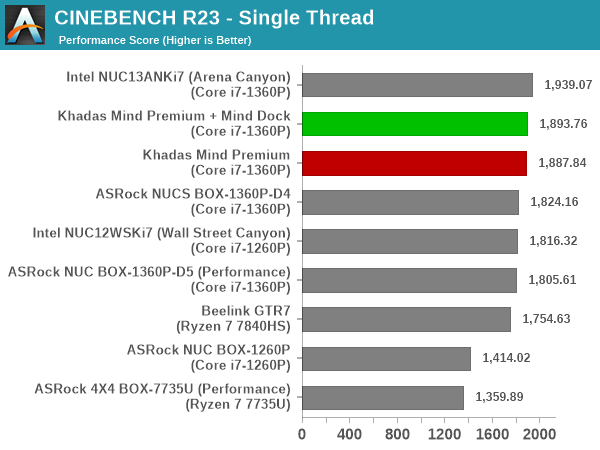
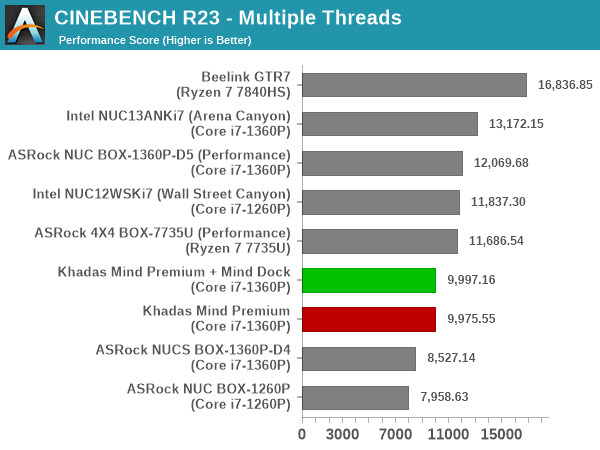
Raptor Lake-P currently holds the advantage over other processor families for single-threaded performance as it relates to CINEBENCH R23. The higher performance core counts in the Beelink GTR7 (and its 65W power budget) gives it a clear lead in the multi-threaded workload. Other systems get ordered according to their sustained power budget, with the 28W Mind Premium configurations falling behind the 40W and 35W configurations.
Transcoding: Handbrake 1.5.1
Handbrake is one of the most user-friendly open source transcoding front-ends in the market. It allows users to opt for either software-based higher quality processing or hardware-based fast processing in their transcoding jobs. Our new test suite uses the 'Tears of Steel' 4K AVC video as input and transcodes it with a quality setting of 19 to create a 720p AVC stream and a 1080p HEVC stream.
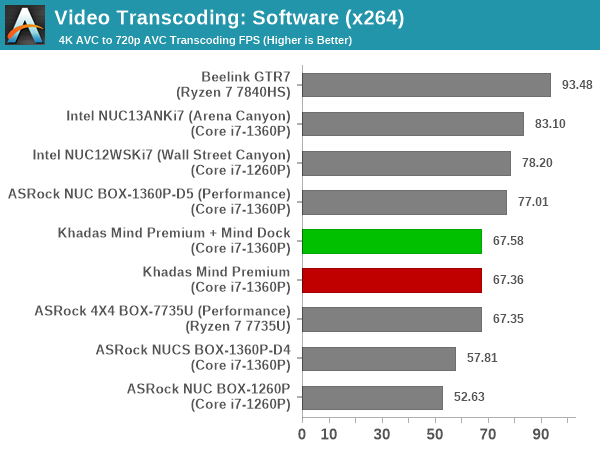
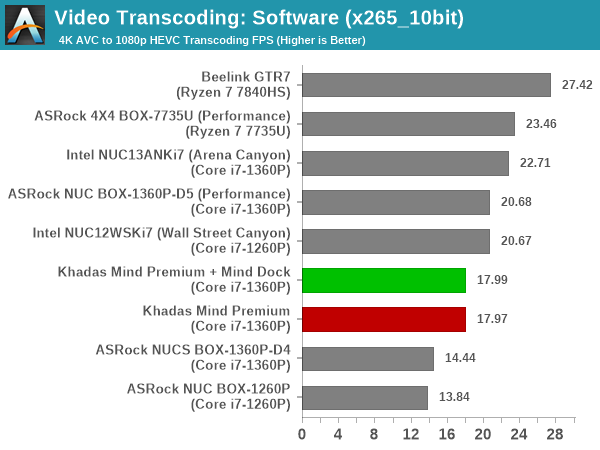
Software transcoding performance is primarily dependent on the number of available cores, assuming that the power budget is the same. Since the relative performance depends on a combination of these two factors, it is no surprise that the Beelink GTR7 with eight Zen 4 cores and a 65W power budget outperforms everything else. The Arena Canyon NUC with a 40W Core i7-1360P outperforms the 28W version in the Mind Premium configurations, with the latter ending up in bottom half of the pack.
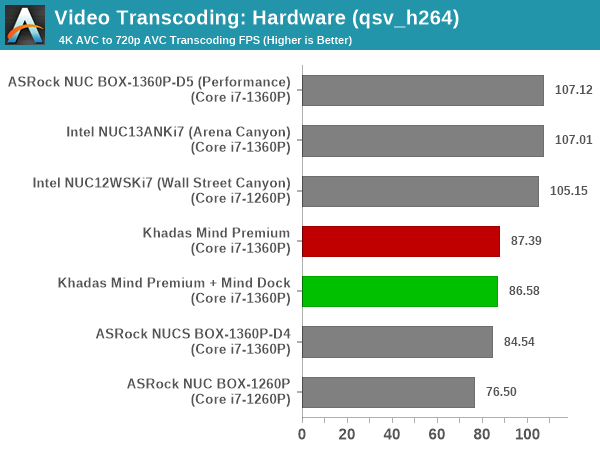
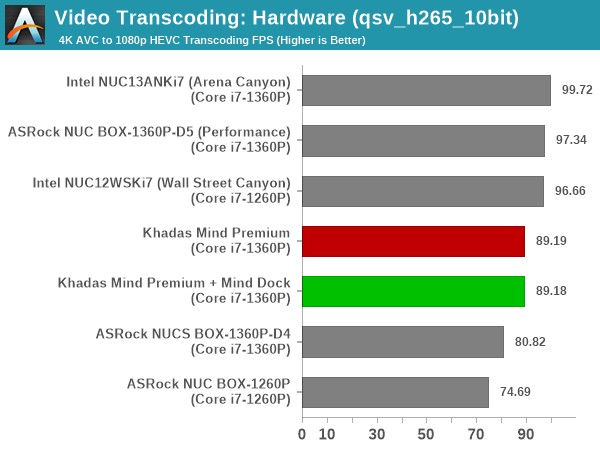
The hardware transcoding performance is simply a function of the GPU clock rate and the power budget available to maintain the sustained clocks. Higher power budgets allow the GPU to remain turbo-clocked for a longer time, and this shows in the Arena Canyon NUC (40W Core i7-1360P) being perched at the top. The 28W version in the Mind Premium configurations pushes the systems towards the middle of the pack.
Archiving: 7-Zip 21.7
The 7-Zip benchmark is carried over from our previous test suite with an update to the latest version of the open source compression / decompression software.

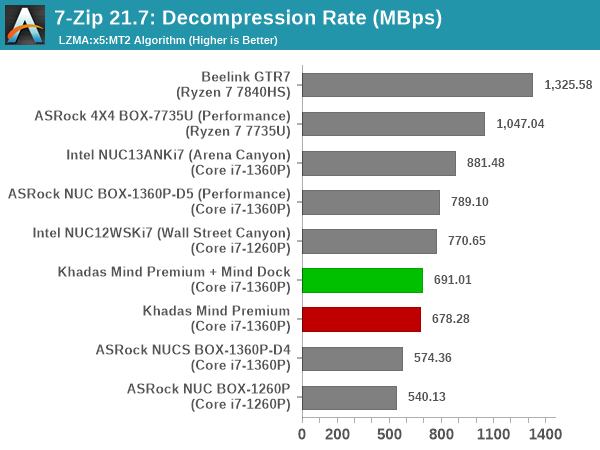
Interestingly, there is not much separating the systems based on the latest generation processors in the compression benchmark. However, the Ryzen-based systems have the edge in decompression. Within the Intel-based set, the ordering is based on the power budget. This sees the 40W configurations surpassing the 28W one used in the Mind Premium systems.
Web Browsing: JetStream, Speedometer, and Principled Technologies WebXPRT4
Web browser-based workloads have emerged as a major component of the typical home and business PC usage scenarios. For headless systems, many applications based on JavaScript are becoming relevant too. In order to evaluate systems for their JavaScript execution efficiency, we are carrying over the browser-focused benchmarks from the WebKit developers used in our notebook reviews. Hosted at BrowserBench, JetStream 2.0 benchmarks JavaScript and WebAssembly performance, while Speedometer measures web application responsiveness.
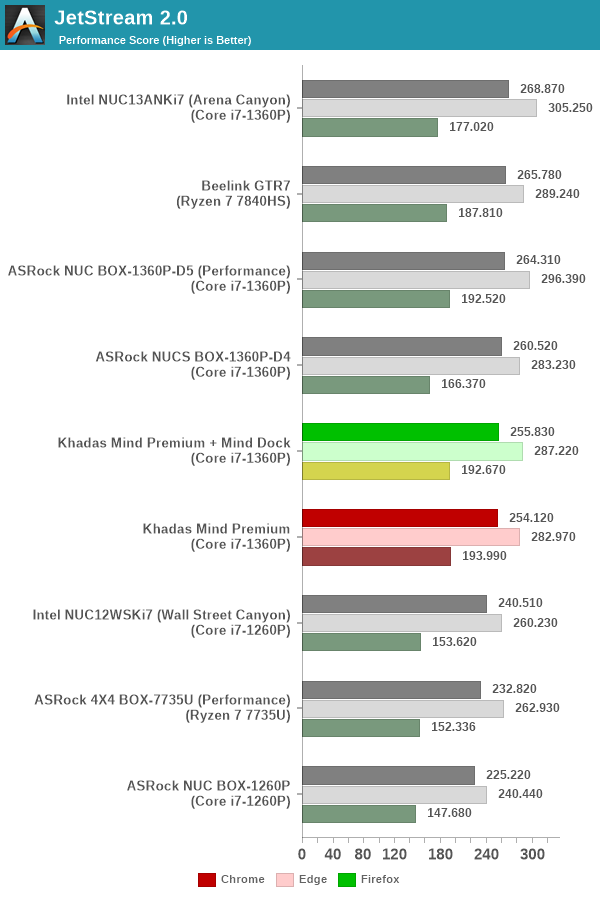
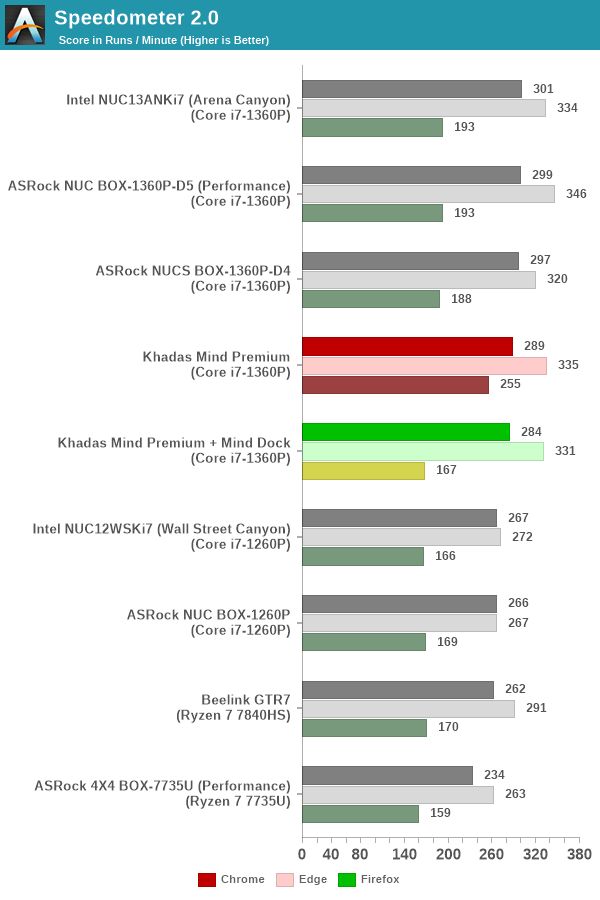
From a real-life workload perspective, we also process WebXPRT4 from Principled Technologies. WebXPRT4 benchmarks the performance of some popular JavaScript libraries that are widely used in websites.
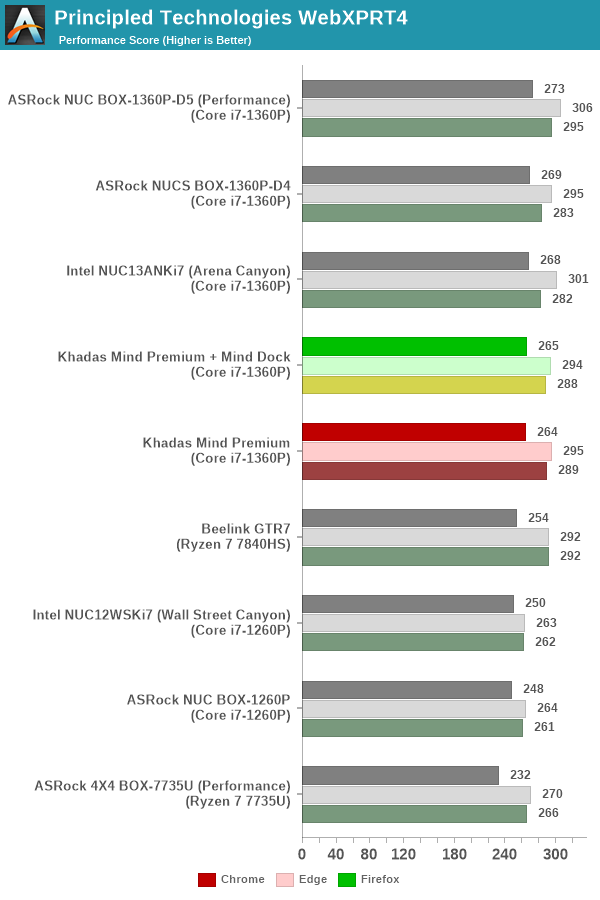
All the three workloads see the 28W Mind Premium systems making its mark in the middle of the graph - systems with higher power budgets are above it, while previous generation products appear below.
Application Startup: GIMP 2.10.30
A new addition to our systems test suite is AppTimer - a benchmark that loads up a program and determines how long it takes for it to accept user inputs. We use GIMP 2.10.30 with a 50MB multi-layered xcf file as input. What we test here is the first run as well as the cached run - normally on the first time a user loads the GIMP package from a fresh install, the system has to configure a few dozen files that remain optimized on subsequent opening. For our test we delete those configured optimized files in order to force a fresh load every second time the software is run.

As it turns out, GIMP does optimizations for every CPU thread in the system, which requires that higher thread-count processors take a lot longer to run. So the test runs quick on systems with fewer threads, however fast cores are also needed. Most of the systems have similar number of cores, and the time taken for application startup is also quite similar in both scenarios - sub-4s in the cached case, and around 8s in the cold case.
Cryptography Benchmarks
Cryptography has become an indispensable part of our interaction with computing systems. Almost all modern systems have some sort of hardware-acceleration for making cryptographic operations faster and more power efficient. In the case of IoT servers, many applications - including web server functionality and VPN - need cryptography acceleration.
BitLocker is a Windows features that encrypts entire disk volumes. While drives that offer encryption capabilities are dealt with using that feature, most legacy systems and external drives have to use the host system implementation. Windows has no direct benchmark for BitLocker. However, we cooked up a BitLocker operation sequence to determine the adeptness of the system at handling BitLocker operations. We start off with a 4.5GB RAM drive in which a 4GB VHD (virtual hard disk) is created. This VHD is then mounted, and BitLocker is enabled on the volume. Once the BitLocker encryption process gets done, BitLocker is disabled. This triggers a decryption process. The times taken to complete the encryption and decryption are recorded. This process is repeated 25 times, and the average of the last 20 iterations is graphed below.
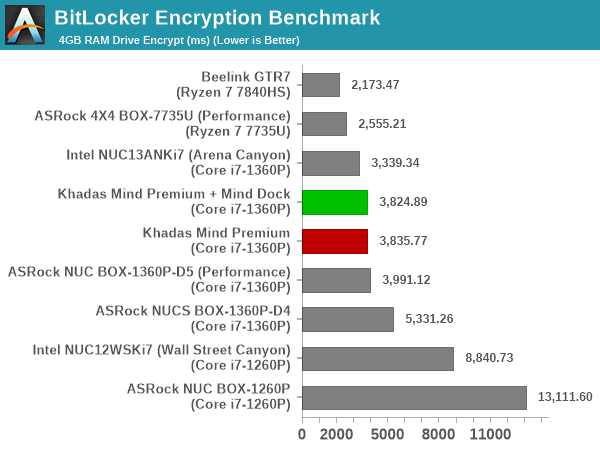
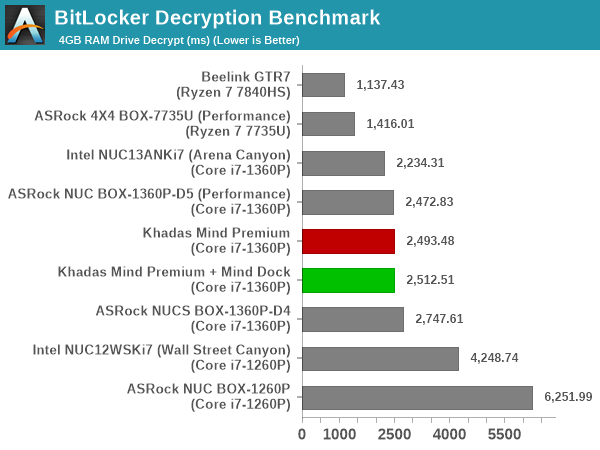
Hardware acceleration is available for the operations in all of the systems. The time taken for processing is directly dependent on the available power budget, as well as RAM speeds. The faster RAM in the 28W configuration results in a narrowed gap between the Mind Premium systems and the Arena Canyon NUC, with the latter enjoying a slight edge.










20 Comments
View All Comments
peterfares - Friday, September 15, 2023 - link
This is really cool, but who is this for?abufrejoval - Friday, September 15, 2023 - link
I’d say it’s mostly for commuters, who’ll oscillate between two or more workplaces with high frequency and regularity, but don’t want to carry more than the “soul” of the computer with them.When I do that, I tend to make that a VM I keep on a high-speed USB stick and I then suspend the VM when I commute. Get’s the job done with a bit of overhead but in a smaller form factor but it means having a physical computer at every workplace and other compromises.
Having a full-sized GPU dock on every location might be somewhat difficult in terms of budget, but a power primary and somewhat after-hours secondary, might be enough to satisfy a large part of the user base.
Being able to just pick up the running machine right in the middle of something and then try catching a train or plane running might seem attractive, but Windows tends to glitch in far too many ways to make that realistic.
I’ve had far too many Windows laptops being woken up from some powersave or even hibernation slumber in the middle of a flight, ostensibly for scheduled maintenance, only to then have them cook themselves and their battery to death for lack of cooling in the onboard luggage: I guess I should be glad they didn’t go as far as combusting, but generally I wound up without a working machine on the busy end of the trip…
If you own a tiny home, operate in a boat, trailer or some other space constrained place this could be cool, but with an eye on longevity I’d not risk anything that wasn’t standards based and if TB isn’t enough, including dGPU, it’s really just tough luck.
BTW, I do believe they offer TB and not just USB4, they just don’t have the certification done, because they do mention eGPU on their website.
Pre-configured only: 32GB is certainly better than 16, even if I’d go for 64, especially at current prices for DRAM. The M.2 slots are only 30mm length so there wasn’t that much variety in terms of updates anyway, but that is currently changing because of these Steam console class devices. I guess the reason they won’t let you open the device is mostly to cut down on customer service issues, because there is just too many people out there who overestimate their technical skills and dexterity.
I guess mostly it just inspired me into looking using a NUC for this commute style use case instead. They aren’t really that much bigger than this, especially if you don’t carry a power brick. Having to make sure they are properly hibernated, isn’t that much of an issue and they are far more economical.
brucethemoose - Friday, September 15, 2023 - link
> 64-48-48-112 @ 5200Whoa, is this a typo?
The timings seem awfully loose, like waay above default JEDEC.
meacupla - Friday, September 15, 2023 - link
I can't even find what JEDEC specifies for LPDDR5Timings for LPDDR have always been looser than their regular counterparts.
They clock higher at lower voltages, and the timings are loose as a result.
Kamen Rider Blade - Friday, September 15, 2023 - link
So, instead of creating a "Proprietary Standard"?Why don't they use the existing PC/104 stacking Board standard that has been around for decades?
meacupla - Saturday, September 16, 2023 - link
PC/104 is meant for internal only. It has exposed and unsupported pins, which makes it easy to bend the pins. It's fragile.This slot connector is a more robust design.
Having said that, oculink and TB4 are plenty robust and have an existing market.
Kamen Rider Blade - Saturday, September 16, 2023 - link
You do know that PC/104 has updated to PCIe/104 and uses PCIe connectors that are plenty strong. Version 3 of the spec has been ratified since Feb 17, 2015.Also it would be pretty easy for them to figure out how to create a base board to stack modules onto given the modular nature.
They could've used a EPIC or EBC MoBo base board and stack modules on top.
meacupla - Saturday, September 16, 2023 - link
not my fault you named the wrong specsjkpublic@gmail.com - Sunday, September 17, 2023 - link
One main difference between this and other NUC's is the LPDDR5. This could have been a show stopper if they broke the 64GB barrier. Would consider a 128GB LPDDR5 memory version. Otherwise not much to see here.xol - Wednesday, September 20, 2023 - link
Polite reminder that "industrial design" means designing a product to be mass produced, not edgelord brushed titanium designed to convinced suckers a product is worth twice its equivalent value